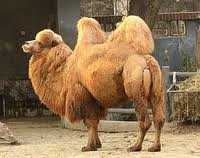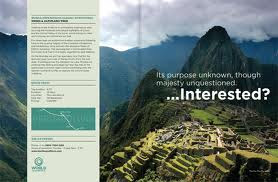As a response to the indesign workshop we had to create a double page spread layout. We were each assigned an animal to research and create an a3 format double page spread on our findings. The animal i was given was the Camel.
Camel research:
A camel is an even-toed ungulate within the genus Camelus, bearing distinctive fatty deposits known as "humps" on its back. The two surviving species of camel are the dromedary, or one-humped camel, which is native to the Middle East and the Horn of Africa; and the Bactrian, or two-humped camel, which inhabits Central Asia. Both species have been domesticated; they provide milk, meat, hair for textiles or goods such as felted pouches, and are working animals.
The term "camel" is derived via Latin and Greek (camelus and kamēlos respectively) from Hebrew orPhoenician gāmāl, possibly from a verb root meaning to bear or carry (related to Arabic jamala).
"Camel" is also used more broadly to describe any of the six camel-like mammals in the family Camelidae: the two true camels, and the four South American camelids: the llama and alpaca are called "New World camels", while the guanaco and vicuña are called "South American camels".
BACTRIAN CAMEL (the one with two humps):
The Bactrian camel (Camelus bactrianus) is a large, even-toed ungulate native to the steppes of central Asia. Of the two species of camel, it is by far the rarer. The Bactrian camel has two humps on its back, in contrast to the single-humped dromedary camel. Its population of two million exists mainly in the domesticated form. Some authorities, notably the International Union for Conservation of Nature (IUCN), use the binomial name Camelus ferus for the wild Bactrian camel and reserveCamelus bactrianus for the domesticated Bactrian camel.
The domesticated Bactrian camel has served as a pack animal in inner Asia since ancient times. With its tolerance for cold, drought, and high altitudes, it enabled travel such as the caravans of the Silk Road. The wild form has dwindled to a population estimated at 800 in October 2002 and has been classified as critically endangered on the IUCN Red List of Threatened Species. Its range in the wild is restricted to remote regions of the Gobi and Taklamakan Deserts of Mongolia and China, migrating from the desert to rivers in Siberia during winter. A small number of wild Bactrian camels still roam the Mangystau Province of southwest Kazakhstan and the Kashmir valley in Pakistan and India.
Here are some images i have sourced off of the internet about Bactrian Camels.
This stamp from mongolia features the bactrian camel. The asian style of the stamp has given me some inspiration for my final double page spread. I like the use of colours and the way the black stamp mark gives the layout a collaged vintage feel. These are design choices that i may use my self to create a mongolian themed double page spread.
DROMEDARY CAMEL (The Arabian Camel):
The dromedary also called the Arabian camel or the Indian Camel (Camelus dromedarius) is a large, even-toed ungulate with one hump on its back. First described by Aristotle of Stagira, the dromedary was given its binomial name by Carl Linnaeus in 1758. The dromedary is the next largest member of the camel family after the Bactrian camel. The oldest known ancestor of the dromedary is the Protylopus. Males are 1.8–2 m (5.9–6.6 ft) tall and females 1.7–1.9 m (5.6–6.2 ft) tall. Males range from 400–600 kg (880–1,300 lb), while females weigh 300–540 kg (660–1,200 lb). They vary in colour from a light beige to dark brown. The notable hump, measuring 20 cm (7.9 in) high, is composed of fat bound together by fibrous tissue.
Their diet includes foliage and desert vegetation, like thorny plants which their extremely tough mouths allow them to eat. The camels are active in the day, and rest together in groups. Led by a dominant male, each herd consists of about 20 individuals. Some males form bachelor groups.
Dromedaries are used as beasts of burden in most of their domesticated range. Unlike horses, they kneel for the loading of passengers and cargo. It has been estimated that a camel can carry 159–295 kg (350–650 lb) for 24 km (15 mi) for a long time. Camels can be trained to bear loads from five years of age, but must not be given a large load until six years old. It has been found that camels are patient animals, easier to train and tougher than cattle. Camels can also be used to pull carts, plow and draw wheels. A dromedary can plow at a speed of 2.5 km (1.6 mi) per hour, but must not be worked for more than six hours a day. Their hair is durable and light, so it is used as a source material for woven goods, ranging from Bedouintents to garments. The hair is clipped off using hand shears, or sometimes simply pulled, after which the camel's body is oiled. Juveniles less than two years of age have a fine undercoat, which is also used for these purposes. They also give wool. The wool produce of a herd of 4300 dromedaries in Russia in 1970 and 1974 was 557 kg (1,230 lb) and 576 kg (1,270 lb) respectively.
I have decided to focus my double page spread on this type of camel as i found a lot more information on them.
ARABIAN DESIGN:
I then looked at arabian design to get a feel for the aesthetics and style of arabian art work and design.
The strong busy patters and sandy tones and shades Influenced my design choices for my double page spread.
NATURAL GEOGRAPHIC:
Probably one of the most famous nature magazines around. I looked ads some of the DPS used by the magazine in order to gain inspiration.
I will employ some of the techniques used in these double page spreads, however i want to be more creative and inventive with my own spread. I like the clean crisp layouts and easy readability of these spreads.
I really like the vintage aged style of this design. I like the colour scheme also. The red and black is southed by the sandy, earthy stock used. The bright red is full of impact and stand out. It is also a very arabic and connotes warmth and desert heat. I am going to use this colour scheme for my own double page spread.
BODY COPY:
Camels /ˈkaməl/ have lived in some of the most desolate corners of our planet, and not only do they live, they thrive. Most large animals are unable to survive in these kinds of desolate places. This is because of their large requirement for resources such as food and water. Camels are able to use this to their advantage as a survival strategy. By living in deserts, mountains, and other arid places Camels are able to avoid predators, and others who would compete for resources. Camels are only able to do this because of their amazing ability to efficiently use the resources their environments provide. A camel can travel long distances which allow them to take advantage of the maximum number of resources. They can withstand a massive amount of dehydration which allow them to survive not only between watering holes, but sometimes between seasons. When at a watering hole camels are able to gorge themselves and rehydrate quickly. For food, camels are omnivorous. They can eat almost anything be it vegetation, meat, or bone, salty or sweet, a camels stomach knows no limits. But it is their temperament that is truly endeared the camel to man. Docile and sweet under a caring hand, but stubborn and angry if ill treated, the camel both wins your heart and your respect. Perhaps nowhere else on earth is more associated with the camel than the Arabian Peninsula. Their story is not one of a free population; however, but of a domesticated animal. Throughout history, Arabian camels have served the needs of humans, and have benefited from that service as a species. Humans have in fact assured the survival of camels for thousands of years and quite literally led them to success as a species that they probably would never have had on their own. The camel has played such an important role in Arab culture that there are over 160 words for “camel” in the Arabic language. The geography and climate have combined to define an entire culture with the camel at its core. This certainly must be seen as high praise of this remarkable animal. As early as 1800 BC, trade routes from Asia and Africa crossed the Arabian Peninsula carrying spices, incense, gold, ivory, and silk on their way to Europe and the lands of the Fertile Crescent. Camels were used by the Nabateans in the first century BC, on their way from the Gulf of Aqaba to the trading capital of Petra in central Jordan. Camels were used by the Bedouin, whose warriors formed the nucleus of the Muslim armies that conquered the Byzantine and Persian Empires in the 7th century AD. War, trade, and civilization - all riding on the back of a hump.
ARABIC TRANSLATION:
جمل = CAMEL
ARABIC TRANSLATION:
جمل = CAMEL























No comments:
Post a Comment